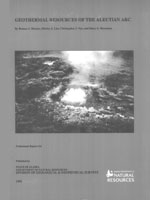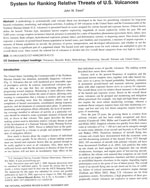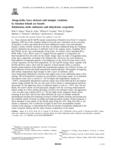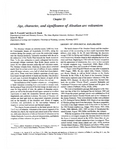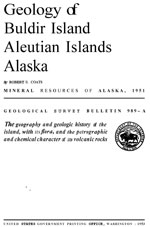References
Andrys, J. L., Coombs, M. L., Cottrell, E., Kelley, K. A., Waters, L. E., and Jicha, B., 2024, Bulk compositions of western Aleutians tephras and lavas collected during leg 3 of the NSF GeoPRISMS shared platform for Aleutians research, Version 1.0: Interdisciplinary Earth Data Alliance (IEDA). https://doi.org/10.60520/IEDA/113465.
Andrys, J.L., 2023, Water and oxygen fugacity in subduction zone magmatism: South Kingstown, R.I., University of Rhode Island, Ph.D. thesis, 389 p.
Cameron, C.E., Crass, S.W., and AVO Staff, eds, 2022, Geologic database of information on volcanoes in Alaska (GeoDIVA): Alaska Division of Geologic and Geophysical Surveys Digital Data Series 20, https://doi.org/10.14509/geodiva, https://doi.org/10.14509/30901.
Waters, L.E., Cottrell, Elizabeth, Coombs, M.L., and Kelley, K.A., 2021, Generation of calc-alkaline magmas during crystallization at high oxygen fugacity: an experimental and petrologic study of tephras from Buldir Volcano, western Aleutian arc, Alaska, USA: Journal of Petrology, p. 1-36, doi:10.1093/petrology/egaa104.
Ewert, J.W., Diefenbach, A.K., and Ramsey, D.W., 2018, 2018 update to the U.S. Geological Survey national volcanic threat assessment: U.S. Geological Survey Scientific Investigations Report 2018-5140, 40 p., https://pubs.usgs.gov/sir/2018/5140/sir20185140.pdf.
Jicha, B.R., and Kay, S.M., 2018, Quantifying arc migration and the role of forearc subduction erosion in the central Aleutians: Journal of Volcanology and Geothermal Research, v, 360, p. 84-99, doi: http://dx.doi.org/10.1016/j.jvolgeores.2018.06.016.
Cameron, C.E., and Snedigar, S.F., 2016, Alaska Volcano Observatory image database: Alaska Division of Geological & Geophysical Surveys Digital Data Series 13, https://www.avo.alaska.edu/images/. https://doi.org/10.14509/29689.
Yogodzinski, G.M., Brown, S.T., Kelemen, P.B., Vervoort, J.D., Portnyagin, Maxim, Sims, K.W.W., Hoernle, Kaj, Jicha, B.R., and Werner, Reinhard, 2015, The role of subducted basalt in the source of island arc magmas: evidence from seafloor lavas of the Western Aleutians: Journal of Petrology, v. 56, n. 3, p. 441-492, doi:10.1093/petrology/egv006
Cameron, C.E., and Nye, C.J., 2014, Preliminary database of Quaternary vents in Alaska: Alaska Division of Geological & Geophysical Surveys Miscellaneous Publication 153, 11 p., doi:10.14509/27357 .
Arndt, Shawn, 2011, Controls of melt genesis and evolution at Buldir volcano in the western Aleutian island arc: University of South Carolina unpublished Masters thesis, Columbia, SC, https://scholarcommons.sc.edu/etd/1318/.
Yogodzinski, G.M., Vervoort, J.D., Brown, S.T., and Gerseny, M., 2010. Subduction controls of Hf and Nd isotopes in lavas of the Aleutian island arc: Earth and Planetary Science Letters, v. 300, p. 226-238, doi: 10.1016/j.epsl.2010.09.035 .
Mastin, L.G., Guffanti, Marianne, Ewert, J.E., and Spiegel, Jessica, 2009, Preliminary spreadsheet of eruption source parameters for volcanoes of the world: U.S. Geological Survey Open-File Report 2009-1133, v. 1.2, 25 p., available at http://pubs.usgs.gov/of/2009/1133/ .
Yogodzinski, G.M., and Bryant, J.A., 2008, Western Aleutian and Kamchatka high-Mg# andesite and dacite [abs.]: in Abstracts of the 18th annual V.M. Goldschmidt conference, Geochimica et Cosmochimica Acta, v. 72, n. 12S, p. A1062.
Ewert, John, 2007, System for ranking relative threats of U.S. volcanoes: Natural Hazards Review, v. 8, n. 4, p. 112-124.
Singer, B.S., Jicha, B.R., Leeman, W.P., Rogers, N.W., Thirlwall, M.F., Ryan, Jeff, and Nicolaysen, K.E., 2007, Along-strike trace element and isotopic variation in Aleutian Island arc basalt: subduction melts sediments and dehydrates serpentine: Journal of Geophysical Research, v. 112, n. B6, 26 p., doi: 10.1029/2006JB004897 .
Wilson, F.H., Mohadjer, Solmaz, Labay, K.A., Shew, Nora, and Grey, D.M., 2006, Digital data for the reconnaissance geologic map of the western Aleutian islands, Alaska: U.S. Geological Survey Open-File Report 2006-1302, 1 p., available online at http://pubs.usgs.gov/of/2006/1302/
Siebert, L., and Simkin, T., 2002-, Volcanoes of the world: an illustrated catalog of Holocene volcanoes and their eruptions: Smithsonian Institution, Global Volcanism Program Digital Information Series GVP-3, http://volcano.si.edu/search_volcano.cfm, unpaged internet resource.
Cameron, C. E., Triplehorn, J. H., and Robar, C. L., 2003, Bibliography of information on Alaska volcanoes: Alaska Division of Geological & Geophysical Surveys Miscellaneous Publication MP 131, 1 CD-ROM.
Hard Copy held by AVO at FBKS - CEC file cabinet
Kelemen, P.B., Yogodzinski, G.M., and Scholl, D.M., 2003, Along-strike variation in the Aleutian Island Arc: Genesis of high Mg# andesite and implications for continental crust, in Eiler, J., ed., Inside the Subduction Factory: AGU Monograph 138, p. 223-276.
Nye, C. J., Queen, Katherine, and McCarthy, A. M., 1998, Volcanoes of Alaska: Alaska Division of Geological & Geophysical Surveys Information Circular IC 0038, unpaged, 1 sheet, scale 1:4,000,000, available at http://www.dggs.dnr.state.ak.us/pubs/pubs?reqtype=citation&ID=7043 .
Hard Copy held by AVO at FBKS - CEC shelf
Alaska Division of Geological & Geophysical Surveys, 1995, Volcanoes of Alaska: Alaska Division of Geological & Geophysical Surveys Information Circular IC 0038, unpaged, 1 sheet, scale 1:4,000,000.
Kay, S. M., and Kay, R. W., 1994, Aleutian magmas in space and time: in Plafker, George and Berg, H. C., (eds.), The Geology of Alaska, Geological Society of America The Geology of North America series v. G-1, p. 687-722.
Hard Copy held by AVO at FBKS - CEC file cabinet
Simkin, Tom, and Siebert, Lee, 1994, Volcanoes of the world [2nd edition]: Tucson, Arizona, Geoscience Press, 349 p.
Hard Copy held by AVO at FBKS - CEC shelf
Myers, J. D., 1994, The geology, geochemistry and petrology of the recent magmatic phase of the central and western Aleutian Arc: unpublished manuscript unpaged.
Hard Copy held by AVO at FBKS - CEC shelf
Fournelle, J. H., Marsh, B. D., and Myers, J. D., 1994, Age, character, and significance of Aleutian arc volcanism: in Plafker, George and Berg, H. C., (eds.), The Geology of Alaska, Geological Society of America The Geology of North America Series v. G-1, p. 723-758.
Motyka, R. J., Liss, S. A., Nye, C. J., and Moorman, M. A., 1993, Geothermal resources of the Aleutian Arc: Alaska Division of Geological & Geophysical Surveys Professional Report PR 0114, 17 p., 4 sheets, scale 1:1,000,000.
Hard Copy held by AVO at FBKS - CEC shelf
Wood, C. A., and Kienle, Juergen, (eds.), 1990, Volcanoes of North America: United States and Canada: New York, Cambridge University Press, 354 p.
Hard Copy held by AVO at FBKS - CEC shelf
Kay, R. W., and Kay, S. M., 1989, Aleutian magmatic systems: an integrated view [abs.]: in Continental magmatism: abstracts, New Mexico Bureau of Mines and Mineral Resources Bulletin 0131, p. 148.
Hard Copy held by AVO at FBKS - CEC file cabinet
Hard Copy held by AVO at FBKS - CEC shelf
Plank, Terry, and Langmuir, C.H., 1988, An evaluation of the global variations in the major element chemistry of arc basalts: Earth and Planetary Science Letters, v. 90, p. 349-370.
Kay, S. M., Kay, R. W., Romick, J. D., and Yogodzinski, G. M., 1986, Spacial variations in trace element ratios in the Aleutian Arc [abs.]: Abstracts with Programs - Geological Society of America, v. 18, n. 6, p. 651.
Luedke, R. G., and Smith, R. L., 1986, Map showing distribution, composition, and age of Late Cenozoic volcanic centers in Alaska: U.S. Geological Survey Miscellaneous Investigations Series Map I 1091-F, unpaged, 3 sheets, scale 1:1,000,000.
Kay, S. M., and Kay, R. W., 1982, Mafic mineralogy in calc-alkaline Aleutian volcanic rocks: evidence for primitive magmas and magma mixing [abs.]: Abstracts with Programs - Geological Society of America, v. 14, n. 7, p. 526.
Marsh, B. D., 1982, The Aleutians: in Thorpe, R. S., (ed.), Andesites: orogenic andesites and related rocks, Chichester, United Kingdom, John Wiley & Sons, p. 99-114.
Hard Copy held by AVO at FBKS - CEC file cabinet
Simkin, Tom, Siebert, Lee, McClelland, Lindsay, Bridge, David, Newhall, Christopher, and Latter, J. H., 1981, Volcanoes of the world: Stroudsburg, PA, Hutchinson Publishing Company, 233 p.
Smith, R. L., Shaw, H. R., Luedke, R. G., and Russell, S. L., 1978, Comprehensive tables giving physical data and thermal energy estimates for young igneous systems of the United States: U.S. Geological Survey Open-File Report 78-0925, p. 1-25.
Hard Copy held by AVO at FBKS - CEC shelf
Powers, H. A., 1958, Alaska Peninsula-Aleutian Islands: in Williams, H., (ed.), Landscapes of Alaska, Los Angeles, CA, University of California Press, p. 61-75.
Coats, R. R., 1956, Reconnaissance geology of some western Aleutian Islands, Alaska: in Investigations of Alaskan volcanoes, U.S. Geological Survey Bulletin 1028-E, p. 83-100, 1 sheet, scale unknown.
Coats, R. R., 1953, Geology of Buldir Island, Aleutian Islands, Alaska: U.S. Geological Survey Bulletin 0989-A, 26 p.
Hard Copy held by AVO at FBKS - CEC file cabinet
Gibson, William, and Nichols, H., 1953, Configuration of the Aleutian Ridge: Rat Islands-Semisopochnoi I. to west of Buldir I.: Abstracts with Programs - Geological Society of America, v. 64, n. 10, p. 1173-1188, 2 sheets, scale unknown.
Coats, R. R., 1947, Reconnaissance geology of some western Aleutian Islands: U.S. Geological Survey Alaskan Volcano Investigations Report 0002, p. 95-105.
Hard Copy held by AVO at FBKS - CEC shelf
U.S. Department of Commerce, and Coast and Geodetic Survey, 1947, United States coast pilot, Alaska Part 2, Yakutat Bay to Arctic Ocean: Washington DC, United States Government Printing Office, 659 p.
Dawson, G.M., 1894, Geological notes on some of the coasts and islands of the Bering Sea and vicinity: Geological Society of America Bulletin, v. 5, p. 117-146.

